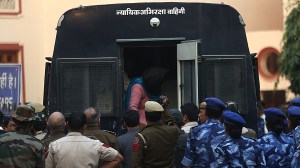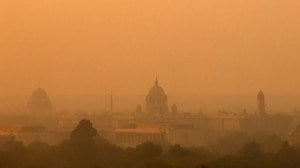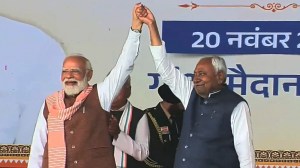Parle vous LIndien?
A show in Paris that starts more than a conversation on Indian art
A show in Paris that starts more than a conversation on Indian art
Four years in the making and spread over nearly 23,000 sq feet dominated by multimedia art video,installations and photography mounted by 30 Indian and 17 French artists,the ambitious and provocative exhibition,Paris-Delhi-Bombay opened at the Centre Pompidou in the French capital last week. The goal of the exhibition,according to curators Sophie Duplaix and Fabrice Bousteau,is not just to explore contemporary Indian art and society,but to promote a dialogue and to develop new and lasting links through an unprecedented collaboration.
Produced mostly by younger artists (Nalini Malani and Vivan Sundaram are the only Indians in their 60s). The show is also deliberately provocative,as if the curators were unafraid to be politically incorrect or aesthetically outmoded. For example,the artist Duplaix who is married to a social scientist from Kerala appears aware of the risks when she titles her catalogue essay,Who is afraid of exoticism? At the political level,the exhibition has much that could agitate a variety of Indians. National flag fanatics,for instance,will be upset by the hybrid Indian/French flag made out of sequins at the gallery entrance ,a glittering tribute by French artist ORLAN to the Indian genius for jugaad creating marvels out of rudimentary things. Without getting so doctrinaire,ORLANs work is a tribute to a famous national trait,and not an insult to the Indian tricolour.
There are more such provocations the shows title itself derides the Shiv Senas only Mumbai dogmatism. The exhibition has enough to annoy Indians from both the right and the left,but the apogee is reached in a roomful of shantytown chic by the suitably tattooed duo of Pierre & Gilles.
In a mandala-style exhibition layout,the kitschy portraits of gods and godfathers by Pierre & Gilles,including a nude Krishna,occupy a central position,an aesthetic sanctum sanctorum,as it were,behind Ravinder Reddys iconic homage to Indias aam aurat.
But do these two French masters of the Indian artistic cliché deserve to be in the show at all? Definitely not,according to several fuming Indian artists already unhappy with the fact that an elementary account of Indias history,politics and culture also gets pride of place at the show. This multimedia presentation is necessary,no doubt,for the uninformed French viewer,but its positioning surely distracts from the aesthetic dynamics of the show.
If the garbha griha itself is sullied,can the temple provide bliss? The answer,perhaps surprisingly,is an emphatic yes. The show has to be seen counter-clockwise,like in an actual temple. The circumambulation reveals several works especially created for the show by Indian and French artists that explore with sensitivity and depth some of the major themes of the show politics and power,urban alienation,environmental depredation,religion,violence,food,sex,identity and nationality.
The focus is heavily layered,and the works crowded together,so the experience is not too dissimilar from a colourful and cacophonous Indian bazaar. For the patient and the resilient,though,there are riches to be discovered.
Many of the French artists visited India before creating works for the show; likewise some Indian artists also visited France. So does the show achieve its objective of initiating a dialogue,among the artists and between what they created? It was so easy to connect,as if Indian and European artists have the same spirit, said Jean-Michel Othoniel,who spent time in Firozabad (UP) to make two enchanting glass creations. But their works are really different. Indian art is more connected to social and human topics; European artists are more focused on their personal story,and use these stories to talk about the world.
Centre Pompidou had originally planned to bring this show to Delhi and Mumbai,after its Paris run gets over on September 19. But the money ran out.
Entering the elevator the next day,I bumped into a visitor from Britain. Going for the Indian show? he asked. Dont miss it it gets under your skin.
My prediction? The art pundits will pan the show,but the public will like it .
(The author is a Delhi-based journalist)



- 01
- 02
- 03
- 04
- 05




























